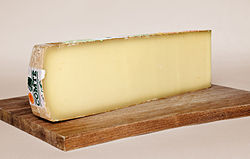Comté cheese
This article needs additional citations for verification. (April 2015) |
| Comté | |
|---|---|
 | |
| Country of origin | France |
| Region, town | Franche-Comté |
| Source of milk | Cows |
| Pasteurised | No |
| Texture | semi-hard |
| Aging time | 8-36 months |
| Certification | French AOC 1958 |
Comté (formerly Gruyère de Comté) (French pronunciation: [kɔ̃.te]) is a French cheese made from unpasteurized cow's milk in the Franche-Comté region of eastern France. Comté has the highest production of all French AOC cheeses, around 40,000 tonnes annually.
The cheese is made in flat circular discs, each between 40 cm (16 in) and 70 cm (28 in) in diameter, and around 10 cm (4 in) in height. Each disc weighs up to 50 kg (110 lb) with an FDM around 45%. The rind is usually a dusty-brown colour, and the internal pâte is a pale creamy yellow. The texture is relatively hard and flexible, and the taste is strong and slightly sweet.
Production
Fresh from the farm, milk is poured into large copper vats where it is gently warmed. Each cheese requires up to 600 litres (160 US gal) of milk. Rennet is added, causing the milk to coagulate. The curds are then cut into tiny white grains that are the size of rice or wheat which are then stirred before being heated again for around 30 minutes. The contents are then placed into moulds and the whey is pressed out. After several hours the mould is opened and left to mature in cellars, first for a few weeks at the dairy, and then over several months elsewhere.
The manufacture of Comté has been controlled by AOC regulations since it became one of the first cheeses to receive AOC recognition in 1958, with full regulations introduced in 1976. The AOC regulations for Comté prescribe:[1]
- Only milk from Montbéliarde or French Simmental cows (or cross breeds of the two) is permitted.
- There must be no more than 1.3 cows per hectare of pasture.
- Fertilization of pasture is limited, and cows may only be fed fresh, natural feed, with no silage.
- The milk must be transported to the site of production immediately after milking.
- Renneting must be carried out within a stipulated time after milking, according to the storage temperature of the milk.
- The milk must be used raw. Only one heating of the milk may occur, and that must be during renneting. It may be heated to no more than 40 °C (104 °F).
- Salt may only be applied directly to the surface of the cheese.
- A casein label containing the date of production must be attached to the side of the cheese, and maturing must continue for at least four months.
- No grated cheese may be sold under the Comté name.
In 2005 the French Government registered 175 producers and 188 affineurs (agers) in France.[2]
Grading
Each cheese is awarded a score out of 20 by inspectors, according to 'overall appearance' (1 mark), 'quality of rind' (1.5), 'internal appearance' (3.5), 'texture' (5), and taste (9). Those scoring 15 or above are given a green casein label with the characteristic image of a green bell and may be called 'Comté extra', with 12-15 being given a brown label and simply called 'Comté'. Any cheese scoring under 3 marks for taste, or under 12 overall is prohibited from being named Comté and is sold as for other purposes in France.
References
- ^ "Décret de l'AOC comté". Retrieved May 14, 2010.
- ^ "Comté". Inao.gouv.fr. Retrieved 2013-09-13.
External links
![]() Media related to Comté (cheese) at Wikimedia Commons
Media related to Comté (cheese) at Wikimedia Commons
